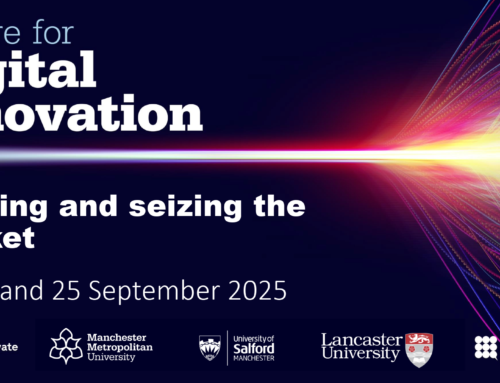AI governance and security: building trust in intelligent systems
Author: Jayasree Varadarajan| AI Technical Analyst Lead| Centre for Digital Innovation| Manchester Metropolitan University
Artificial Intelligence (AI) is transforming industries from healthcare and finance to manufacturing and retail by enabling smarter automation, faster decision-making, and deeper insights. Yet, as implementation accelerates, so do concerns around data privacy, algorithmic bias, model misuse, and lack of accountability. These issues have sparked global conversations around AI governance and security.
For organisations, especially SMEs exploring AI-based prototyping and solutions, understanding AI governance and security isn’t just a governing checkbox; it’s significant for building trustworthy, responsible, and robust AI systems.
What is AI Governance?
AI Governance refers to the framework of policies, procedures, tools, and standards that guide the responsible development, deployment, and use of AI systems. It encompasses ethical, legal, and operational principles to ensure that AI systems:
- Comply with laws and industry standards
- Operate transparently and fairly
- Are explainable and auditable
- Align with human values and organisational objectives
It’s similar to corporate or IT governance, but AI Governance goes further by addressing unique risks such as algorithmic discrimination, autonomous decision-making, and unintended consequences of learning models.
AI Security: Protecting Data, Models, and Infrastructure
This is about safeguarding AI systems from malicious attacks, adversarial manipulation, data leaks, and intellectual property theft. Unlike traditional software, AI systems are more vulnerable because they rely on dynamic data, statistical patterns, and probabilistic decision-making.
Key areas of AI security include:
- Model poisoning: Introducing biased or harmful data into training sets
- Adversarial attacks: Crafting inputs that fool the AI into incorrect outputs (e.g., misclassifying images)
- Data extraction: Leaking sensitive training data through model queries
- Model theft: Reverse-engineering proprietary models via repeated interactions
These risks call for technical safeguards (like robust training pipelines, input sanitisation, and secure APIs) and policy-level controls.
Core Principles of AI Governance and Security
Transparency and Explainability
Stakeholders should be able to understand how decisions are made. Black-box models (e.g., deep neural networks) should include tools for interpretation, such as:
- SHAP/LIME: Local model explanations
- Model cards: Documentation for model intent, use, and performance
- Data lineage tracking: Understanding where training data came from
Accountability
Responsibility for AI actions should be clearly defined. This includes:
- Maintaining logs of decision-making processes
- Defining roles for data stewards, model owners, and ethical reviewers
- Enabling audit trails for model behavior over time
Fairness and Non-discrimination
AI models should not amplify biases based on race, gender, age, or disability. Techniques to ensure fairness include:
- Bias detection tools like IBM’s AI Fairness 360
- Balanced training datasets
- Regular fairness audits at deployment and post-deployment stages
Data Privacy and Protection
Protecting training and inference data is key. Compliance with GDPR, HIPAA, and other privacy regulations requires:
- Data anonymisation
- Differential privacy in training processes
- Access controls for sensitive datasets
Security by Design
Security must be built into every stage of the AI lifecycle:
- Use version-controlled model repositories
- Implement secure API gateways
- Adopt adversarial robustness testing
AI Governance Frameworks and Standards
Several institutions have proposed frameworks to guide responsible AI use:
- EU/AI Act – published by European Union, focuses on risk-based AI regulation
- NIST AI Risk Management Framework, published by U.S. National Institute of Standards Technology, focuses on risk mitigation across the AI lifecycle
- ISO/IEC 42001 (AI Management), published by International Standards Organisation, focuses on AI governance standards
- OECD AI Principles, published by Organisation for Economic Co-operation and Development, focuses on human-centric and transparent AI.
Organisations adopting these frameworks can better prepare for compliance, market trust, and ethical certifications.
AI Governance and Security in SMEs: Challenges and Solutions
While large enterprises may have dedicated AI ethics boards or CISO teams, SMEs face resource constraints. Yet, governance and security are equally crucial, especially during prototyping and early product development.
Key Challenges
- Limited technical expertise in AI regulation and risk management.
- Lack of internal security infrastructure.
- Fast-paced innovation often overlooks governance checks.
Suggested Solutions
- Start with lightweight governance models: Use simple documentation, versioning, and ethical checklists.
- Use open-source toolkits for security scanning and fairness evaluation.
- Partner with AI governance consultants or accelerators who provide structured support.
- Engage in cross-functional reviews early in the development phase.
Real-World Example: Responsible AI in a Chatbot Prototype
A UK-based SME developed a mental health support chatbot using a local LLM. While the prototype performed well in pilot testing, our governance review raised concerns:
- The model sometimes hallucinated medical advice.
- There was no clear boundary between high-risk and low-risk queries.
- Data logging lacked encryption.
We implemented the following:
- Added rule-based guardrails around sensitive topics.
- Introduced a human-in-the-loop escalation workflow.
- Applied input validation and sanitisation.
- Stored logs using hashed user IDs to protect privacy.
As a result, the SME gained trust from stakeholders and was able to pilot the solution in clinical settings.
Find out more about this real-world example
Future Outlook: AI Governance as a Competitive Advantage
As regulations tighten and AI adoption grows, having a mature AI governance and security approach will no longer be optional—it will be a competitive differentiator.
Organisations that can demonstrate:
- responsible AI practices,
- privacy-by-design principles,
- security-tested models,
will attract more funding, gain faster approvals, and enjoy better public trust.
Conclusion
AI governance and security are not barriers to innovation but enablers of sustainable, ethical, and trustworthy AI adoption. Whether you’re building a chatbot for customer service or a predictive model for logistics, embedding governance early can help your innovation thrive long-term.
At Centre for Digital Innovation, we believe in co-creating AI prototypes with our SME partners while prioritising governance and security every step of the way. It’s how we help turn bold ideas into safe, scalable, and impactful solutions.
Reference:




